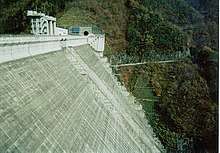Kazunogawa Pumped Storage Power Station
The Kazunogawa Pumped Storage Power Station is a pumped-storage hydroelectric power station near Kōshū in Yamanashi Prefecture, Japan. The station is designed to have an installed capacity of 1,600 megawatts (2,100,000 hp) and three of the four 400 megawatts (540,000 hp) generators are currently operational, for a total operational capacity of 1200 MW. Construction on the power station began in 1993 and the first generator was commissioned on 3 December 1999. The second was commissioned on 8 June 2000. The third on become operational on 9 June 2014, six year early due to post-power demand from the Great East Japan earthquake. The fourth and final generator is slate to be commissioned by 2024. It is owned by TEPCO and was constructed at a cost of US$2.2 billion.[4][5]
| Kazunogawa Pumped Storage Power Station | |
|---|---|
 The upper Kamihikawa Dam | |
| Country | Japan |
| Location | Kōshū |
| Coordinates | 35°43′07″N 138°55′47″E |
| Status | Operational |
| Construction began | 1991 |
| Opening date | Unit 1: 1999 Unit 2: 2000 Unit 3: 2024 Unit 4: 2014 |
| Construction cost | $2.2 billion USD[1] |
| Owner(s) | TEPCO |
| Upper reservoir | |
| Creates | Kamihikawa Reservoir |
| Total capacity | 11,470,000 m3 (9,300 acre⋅ft)[2] |
| Lower reservoir | |
| Creates | Kazunogawa Reservoir |
| Total capacity | 11,500,000 m3 (9,300 acre⋅ft)[3] |
| Power Station | |
| Hydraulic head | 779 m (2,556 ft) (max) |
| Pump-generators | 3 x 400 MW (540,000 hp) reversible Francis-type |
| Installed capacity | 1200 MW Planned: 1600 MW |
Design and operation

The upper reservoir for the power station is created by the Kamihikawa Dam at 35°42′58″N 138°49′57″E which is a 87 metres (285 ft) tall and 494-metre (1,621 ft) long rock-fill embankment type. It has a fill volume of 4,110,000 cubic metres (5,380,000 cu yd). The upper reservoir's capacity is 11,470,000 cubic metres (9,300 acre⋅ft) of which 8,300,000 cubic metres (6,700 acre⋅ft) is active (or "useful) for power generation.[2] The lower reservoir is formed by the Kazunogawa Dam (葛野川ダム), which uses water from the Sagami River system. The Kazunogawa Dam is 105.2 metres (345 ft) tall and 263.5 metres (865 ft) long roller-compacted concrete gravity dam. It has a structural volume of 622,000 cubic metres (814,000 cu yd). The lower reservoir's capacity is 11,500,000 cubic metres (9,300 acre⋅ft) of which 8,300,000 cubic metres (6,700 acre⋅ft) is active (or "useful) for pumping into the upper reservoir.[3]
When energy demand is high, water from the upper reservoir is released down to the underground power station via a single 3.3 kilometres (2.1 mi) long headrace tunnel which splits into two 1.8 kilometres (1.1 mi) tunnels before each separate into two 620 metres (2,030 ft) long penstocks. Each penstock feeds a single reversible 400 MW Francis turbine-generator with water before it is released into a 3.3 kilometres (2.1 mi) long tailrace tunnel which discharges into the lower reservoir. When energy demand is low and therefore inexpensive, the turbines reverse into pumps and send water from the lower reservoir back to the upper reservoir. The process is repeated when necessary to help balance electricity loads. The difference in elevation between the upper and lower reservoirs affords an effective hydraulic head of 714 metres (2,343 ft) and maximum of 779 metres (2,556 ft).[1][6][7]
See also
- Fukashiro Dam – located downstream of Kazunogawa Dam
- List of pumped-storage hydroelectric power stations
References
| Wikimedia Commons has media related to Kamihikawa Dam. |
- "Kazunogawa Hydroelectric Power Plant, Japan". Power-Technology. Retrieved 14 August 2011.
- "Kamihikawa" (in Japanese). DamSite. Retrieved 14 August 2011.
- "Kazunogawa" (in Japanese). DamSite. Retrieved 14 August 2011.
- "Outline of Kazunogawa Hydroelectric Power Station" (PDF). TEPCO. 9 June 2014. Retrieved 14 July 2014.
- "Commercial Operation Commencement of Unit 4, Kazunogawa Hydroelectric Power Station". TEPCO. 9 June 2014. Retrieved 14 July 2014.
- Yoshikawa, Hiromichi. "A Huge Pumped-Storage Hydroelectric Power Plant on the Kazuno River -Effective Head of 714 m-". Musashi Institute of Technology. Archived from the original on 28 September 2011. Retrieved 14 August 2011.
- "Kazunogawa Pumped-storage Power Station" (in Japanese). CKJ3D. 23 August 2009. Archived from the original on 7 January 2012. Retrieved 14 August 2011.